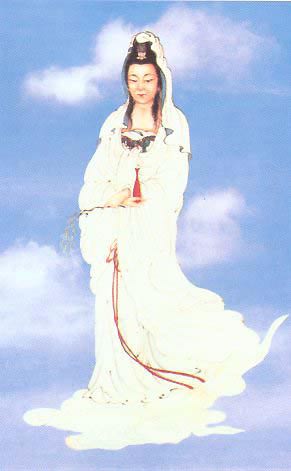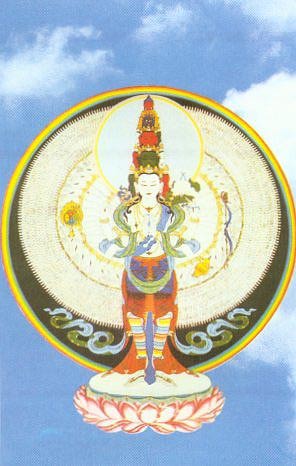"Namo Ta-Chi-Ta-Pei Kuan Shih Yin P'usa". is is the prayer
which is recited by all Kuan Yin devotees daily to pay homage
and to appeal to the Great Lord, AVALOKITESVARA Bodhisat va,
who is the compassionate aspect of all the Buddhas of the three
aeons. Literal y translated it means "Namo To e Greatly
Compassionate Kuan Shih Yin Bodhisat va". To recite this
prayer is to seek the blessings of Kuan Yin and at the same time
to develop one's own compassionate nature. ose who recite the
great prayer with a sincere heart will surely find it quite easy to
practise great kindness and great sympathy towards others, for
Kuan Yin's compassion will then flow through them and cause
them to walk the Path of Mercy. It is also the Path towards
Buddhahood for the merit and virtue of reciting the name of the
great P'usa is immeasurable.
is great Compassionate Lord is known by various other names
such as:
"e Bodhisat va Regarder of the Sound of the World:"
"e Lord of Compassionate Glances."
"e Lord Who Sees the World with Pity."
"e Lord of What is seen, of the Visible World."
and a host of other names. He is indeed the Lord who regards
with compassion, all beings suffering from the evils of existence
within the Six Realms.
KUAN SHIN YIN is the direct translation of the Sanskrit name of
Avalokitesvara which has the fol owing meaning:
KUAN -- `contemplate' or `looks on'
SHIH -- the world or the region of sufferers'
YIN -- `all the sounds of the world,' i.e., the cry-
ing sounds of beings, verbal or mental, all
acknowledging misery and seeking salvation
which touch the heart of the Lord who pities.
Kuan Shih Yin is therefore the Bodhisat va of great compassion,
mercy and love who has won the hearts of countless people. By
virtue of his infinite power, he is capable of regarding the cries
of the people whether these represent either desire or suffer-
ing, delivering them through the wisdom of skilful means, and
appearing in the form suitable to those to be saved. is noble
Lord is thus the `saviour' who may assume the form of a Buddha,
Bodhisat va, god or any other forms, either male or female, in
order to fulfill his task of mercy.
In most of the Buddhist lands, the male form is predominant
but in China, Kuan Shih Yin manifests in various female forms
such as:
"White-robed Kuan Yin"
"Child-giving Kuan Yin"
"Calm-sea Kuan Yin"

KUAN SHIN YIN P'USA -- AVALOKITESVARA BODHISATTVA
reasons for these female emanations are because of the then
Confucianist influence on the at itude, customs and social sys-
tems which discouraged the female population from seeking
comfort and solace from male deities especial y in their requests
for off-spring.
Kuan Yin, in fact, manifested into 33 forms with which to reach
the people and the most popular ones being:
Kuan Yin of Complete Light
Dragon-head Kuan Yin
Kuan Yin Who Views Waterfal s
Child-giving Kuan Yin
Kuan Yin of the Fish Basket
Kuan Yin of the Rock Cave
Kuan Yin of Universal Compassion
Kuan Yin Holding a Lotus
It should also be mentioned that even before Buddhism was
introduced into China, the women folk there were already wor-
shipping several female Taoist Deities, in the forms of `Niang-
Niang' seeking their blessings for safety, happiness, children,
mercy, compassion and salvation. us when Kuan Shih Yin
responded to the urgent and distressful cal s of the Chinese peo-
ple in the female forms, they were also given the `Niang-Niang'
titles so that Kuan Shih Yin P'usa which is the proper Buddhist
term, became known as Kuan Yin Niang Niang or e Goddess
of Mercy. In this way, Avalokitesvara became the most popular
deity in all of China, worshipped by both the Buddhists and
the Taoists as well as those who are without a proper faith but
needed a compassionate deity to turn to.
Kuan Yin's manifestations or transformation bodies can be said
to be numberless and the most widely worshipped form today
is that of the White-robed Kuan Yin. For this reason, most
of the Kuan Yin images that are seen in temples and at home
altars are related to this form. Since this is the most beloved of
al the forms, one should take a closer look at it to discover its
endearing features which have captured the hearts of countless
mil ions.
Kuan Yin images are either in a seated or standing posture each
having its significant meanings. Most people tend to prefer the
seated form as it gives both a serene and dignified feeling, the
very picture of enlightenment. e standing figure represents
compassion in action. What does it indicate? It real y indicates
that Kuan Yin's compassion and saving power are available to
anyone who seeks them, that Kuan Yin is ever ready to reach
and help al beings by offering them assistance, love and protec-
tion. is posture also symbolises the eternal activity of bring-
ing enlightenment to al who wish it. Kuan Yin is also depicted
as holding a vase which contains `Amrita', the dew of compas-
sion, which can purify the defilements of our body, speech and
mind, as wel as having al kinds of curative powers. e face of
Kuan Yin images is always gentle, calm and enduringly sweet,
an expression which reflects infinite wisdom, serenity, love and
compassion. It has the peculiar quality of calming those who
are angry or are in despair, comforting those who are sorrow-
ful, and bringing forth feelings of love, devotion and content-
ment to her faithful. How does one become her faithful? Not
by blind faith or through worship which is tinged with selfish
intentions but through the practice of such virtues as kindliness,
gentleness, love, mercy, compassion, charity, morality, patience,
perseverance, contemplation or acts that wil bring benefits to
others, one becomes a true disciple of Kuan Shih Yin. Another
feature that should be noted is the eyes which are always depict-
ed as `half-opened and half-closed' which indicates a perfect
harmony of outer and inner life as half of the vision is concern-
ing the outer world, while the other half is directed internal y
for proper self-reflection. us it can be said that Kuan Yin is
ever mindful of the external world and al our internal thoughts
and inclinations.
As mentioned earlier, Kuan Yin forms are many, in fact they
are said to be countless, and each of these forms has its own
significant and symbolic meaning. ose who are new to
Mahayana Buddhism should not be startled by the various forms
of the Buddhas and Bodhisattvas, especial y by the number of
arms that they are often depicted with. One of Kuan Yin's
most famous and compassionate forms is that of the `thousand-
arm-thousand eyes' which is known in Chinese as `Chien-shou-
chien-yen Kuan Shih Yin P'usa. In this form, Kuan Yin has
eleven heads and a thousand hands, with extra eyes on the
palms of each hand. Legend has it that he was contemplating
the task of working for the safety and happiness of al sentient
beings when his head split into a thousand pieces upon realising
the enormity of such an undertaking. Amitabha, the Buddha
of Limitless Light, his Spiritual Father, quickly came to the
rescue and restored Kuan Yin to life and also gave him this
form. e thousand eyes symbolise the al -seeing nature of
Kuan Yin's compassion while the thousand arms represent the
ever-present and al -compassing nature of his help. Al Kuan
Yin images, male or female, with one or multiple heads, two
or multiple arms, gentle or fierce facial expressions, have their
own symbolic and religious meanings and therefore should not
be looked upon as peculiar and uninviting. However, al Kuan
Yin images always feature a loving, kind and compassionate
expression and even a statue with eleven heads and a thousand
arms does not lose the harmony of the whole body but radiates
peace.
In the Lotus Sutra, an entire chapter is devoted to Kuan Yin in
which the Buddha describes the Bodhisat va as one who has her
face turned in every direction in order to see all things and to
save all beings and that there is no form or shape that Kuan Yin
will not assume to preach the Dharma to sentient beings:
"In some worlds... the Bodhisat va Mahasat va Avalokitesvara
preaches the law to creatures in the shape of a Buddha; in others
she does so in the shape of a Bodhisat va. To some beings she
shows the law in the shape of a Pratyekabuddha; to others she
does so in the shape of a disciple... to those who are to be con-
verted by assuming Brahman, she preaches in the shape of a
Brahman; to those who are to be converted by Vajrapani, she
preaches in the shape of Vajrapani."

CHIEN-SHOU-CHIEN-YEN -- KUAN SHIH YIN P'USA
¡ûBACK¡û |INDEX| ¡úNEXT¡ú